Giving back to those giving so much
February 11, 2010
To help returning veterans with the sometimes tumultuous transition to civilian life, the Board of Supervisors at its Tuesday meeting will consider a proposal to create four new positions to advise veterans on matters of mental health, substance abuse, homelessness and legal and family issues.
The advisors would join a new Veteran Systems Navigator program, designed to assist those returning from “combat to community,” including vets straining to reintegrate. With the influx of veterans returning from Iraq and Afghanistan, there is an increasing need for mental health care, according to county officials.
The new advisors, who will be funded with California Proposition 63 (Mental Health Services Act of 2004), will help these veterans navigate the Veterans Administration as well as services offered by the county, said Joseph N. Smith, director of the County’s Department of Military and Veterans Affairs. Smith, a retired Marine colonel, said “there are more needs than the VA can handle.”
Together with an existing staffer, the hires would allow the department to place one veterans specialist in each of the five supervisorial districts. The four staffers would be transferred from the county’s Department of Mental Health.
Seeking a better two-wheel vision of L.A.
February 11, 2010
 If you bicycle in Los Angeles, the Metropolitan Transportation Authority needs you.
If you bicycle in Los Angeles, the Metropolitan Transportation Authority needs you.
Specifically, they need you to show up for their first Bicycle Roundtable on Friday, Feb. 19, from 2 p.m. to 4 p.m.
The idea is to “initiate a dialogue and identify issues of importance to cyclists in Los Angeles County that will help create a vision for enhancing Metro’s current bicycle program.”
The meeting comes as bicycles occupy an increasingly important place on the regional transportation agenda, with the city and county of L.A. both creating new master plans for cycling. Bikeways are in the news, too, including a federally-funded bikeway being planned to run from downtown to Santa Monica, adjacent to the Expo Line currently being built.
Doug Failing, former head of Caltrans Bicycle Advisory Committee and now Metro’s New Executive Director of Highway Programs and Interim Chief Planning Officer, will get things started at the roundtable.
There’s bicycle parking at One Gateway Plaza (“between the fish tank/customer service center and Metro elevators”) and lots of public transportation options for getting there (naturally) at the link above.
Return of the Mini-Vib
February 10, 2010
 The Mini-Vib’s back, and this time it’s bringing along its seismic sidekick, the Micro-Vib.
The Mini-Vib’s back, and this time it’s bringing along its seismic sidekick, the Micro-Vib.
Westside subway extension planners are sending the Mini-Vib truck back into service next week on a new stretch of Selby Avenue north of Santa Monica Boulevard in Westwood. The vibration-creating vehicle will roll over sensors in the street between 8:30 a.m. and 5 p.m. on Monday, Feb. 15. (The work was scheduled on the President’s Day holiday to avoid disrupting classes at Emerson Middle School.) This round of testing comes after preliminary data suggested going a little further north on Selby with the Mini-Vib.
That work will be followed up with an appearance by the Micro-Vib on Wednesday and Thursday nights on Selby Avenue from Santa Monica Boulevard north. The hand-held “vibration box” is designed to produce gentler vibrations than the truck. With noise levels of around 60 decibels—about as loud as normal conversation–it will be used between 9 p.m. to 6 a.m. both nights. More Micro-Vib tests may be scheduled for Saturday, Feb. 27 as well.
The Mini-Vib truck also will be paying a return visit to Century Park West next week. Testing will take place on Tuesday, Feb. 16 from 9 p.m. to 6 a.m. between 1930 Century Park West and Santa Monica Boulevard. The work is needed because of a malfunction during the earlier round of testing.
This letter to residents, posted by Metro’s blog The Source, has more on the testing process, and describes the impact on traffic, including lane closures on Santa Monica Boulevard the night of Tuesday, Feb. 16.
Ultimately, results of the field seismic tests will be used to help determine routes for tunnels connecting the Century City and Westwood/UCLA subway stations. The research centers on a branch of the Santa Monica fault in the area. Full information on the project, which is still in the planning stages, can be found here.
In WeHo, a new home and new hope
February 10, 2010
After living with a succession of friends and relatives for more than three years, no wonder Michael Wojtkielewicz gets passionate when he talks about landing an apartment of his own.
“It’s going to mean everything to me,” he says. “There is a huge security knowing you have a home. It’s yours today and it will be yours tomorrow.”
At age 47, the retired architect is preparing to move later this month into the Sierra Bonita Apartments in West Hollywood, an innovative 42-unit mixed-use project on Santa Monica Boulevard for low-income disabled residents like Wojtkielewicz. With his schnauzer named Psquared, Wojtkielewicz aims to turn his new place into the first stable home he’s had since losing his job and apartment several years ago after he was leveled by the onset of stress-related immune illness and bipolar disorder.
The West Hollywood Community Housing Corporation project, which is still under construction, will be home to residents with physical and mental disabilities, along with those who suffer such chronic illnesses as diabetes and HIV/AIDS, says Executive Director Robin Conerly. WHCHC and another non-profit will take up shop in the building’s street-level commercial space.
Residents will move in starting in mid-February. Their rents will be fixed at two amounts, based on a tenant’s income. Those who make 30 percent or less of the county’s median income as calculated by federal housing officials (about $48,000) will pay $382 per month; the cost will be $531 for residents with incomes up to 40 percent of the county median. The one bedroom units can accommodate single tenants, couples and families with one child.
Wojtkielewicz, who’ll live on the fifth floor—the top floor—knows he was “really, really lucky” to get one of the apartments. He was one of 2,017 applicants. His name came up No. 11 in a September lottery.
Wojtkielewicz is hoping that his good fortune is a sign that his life is turning around after a run of painful years.
Wojtkielewicz had been a residential and commercial architect at a series of L.A.-area firms for 20 years when he was stricken with a stress-related immune disorder in 2005. The illness caused painful staph infections on his chest, arms and legs. Separately, he was diagnosed with bipolar disorder.
Around the same time, he lost his job when clients dried up at the two-man design firm, where he’d been working as a contract architect.
In pain and “mentally pretty much shattered,” Wojtkielewicz says he couldn’t bring himself to look for another job. Low on savings, he gave up his apartment of 16 years and moved to a friend’s place in 2006. “When you can’t work,” he said, “you’re no longer able to pay rent.”
He shifted between homes in Los Angeles and West Hollywood, and also took up residence with family members in Pennsylvania. For the last year, Wojtkielewicz has lived with a sick friend in Silver Lake, acting as his caretaker.
Things began looking up last winter when the friend told Wojtkielewicz he’d seen the Sierra Bonita construction site and learned it was reserved for low-income disabled people. The two hopped on a bus to have a look. Wojtkielewicz liked what he saw and signed up for the lottery. By then, he’d qualified for a federal Supplemental Security Income disability payment of $1,335 a month.
With his architectural training, Wojtkielewicz is excited about living in the stylish new building with floor-to-ceiling windows and a rooftop garden. Designed by architect Patrick Tighe, the $20.7 million project uses such state-of-the-art green-building features as interior courtyards that circulate cool air, high-efficiency air conditioning and artistic grids of solar panels on the roof and exterior walls. Its development became a pilot project for West Hollywood’s 2007 green building ordinance.
Among the projects funders are the city of West Hollywood, which put up $6.5 million, and Los Angeles County, which supplied a combined $14 million in loans and bonding authority through the Community Development Commission.
To make sure residents get the help they need, a services coordinator from Jewish Family Service will work at the building. The L.A. Gay & Lesbian Center and AIDS Project LA plan to provide HIV/AIDS care and other services.
Now Wojtkielewicz says he wants to give back a bit of what he’s been given. So he plans on volunteering for a social services agency. He says he also wants to reconnect with friends that he’s lost touch with since his troubles began. “I think having [my own place] is going to make me want to participate in new activities,” he says confidently.
Maybe that’s why he sent a note of gratitude to Lee Meyers, WHCHC’s director of residential services. In it, he quoted a tagline from an IKEA ad he remembered fondly that now rings with a special resonance for him: “Home – The Most Important Place in the World.”
Ballard Mountain dedication set
February 10, 2010
 John Ballard’s mountain is finally getting its rightful name. The peak, named after the pioneering African-American homesteader, will be formally dedicated on Saturday, Feb. 20 at a ceremony in Agoura Hills. Guests will include Ballard’s descendants and the director of the U.S. Geological Survey, Marcia McNutt.
John Ballard’s mountain is finally getting its rightful name. The peak, named after the pioneering African-American homesteader, will be formally dedicated on Saturday, Feb. 20 at a ceremony in Agoura Hills. Guests will include Ballard’s descendants and the director of the U.S. Geological Survey, Marcia McNutt.
Ballard, one of Los Angeles’ early black pioneers. first established himself in the city in 1859. He eventually relocated with his family in the 1880s to the mountain area known today as Seminole Hot Springs, filing a homestead claim in 1880 and receiving his homestead patent in 1900.
His mountain was known for decades as “Negrohead Mountain” and before that by a similar name containing a racial slur. The campaign to rename the mountain in Ballard’s honor originated with neighbors in the area, and the cause was taken up by Los Angeles County Supervisor Zev Yaroslavsky. Their efforts culminated with the United States Board on Geographic Names making the change last September.
A link to our earlier coverage can be found here.
Strengthening the safety net for the county’s neediest
February 9, 2010
A major overhaul of the General Relief safety net came closer to reality on Tuesday when the Board of Supervisors approved an initiative aimed at improving the quality of life for the county’s indigent residents while achieving large welfare savings in the future.
By unanimous vote, the supervisors approved implementation plans for a set of 42 reforms of the county’s General Relief program, including a number of measures they approved in principal last fall.
The General Relief program, administered by the Department of Public Social Service, has come under intense financial pressure during the current recession as the client population rocketed from 61,000 to 87,000 in the past two years. Spending on general relief clients is expected to come to about $1 million this year.
The reforms are intended to improve the delivery of services while saving the county money by focusing efforts on helping clients qualify for larger federal and state disability benefits. Currently, the county spends about $210 million to pay clients monthly checks of $221. In addition, the indigent clients cost the county another $800 million in other services, including hospital emergency room treatments.
The restructuring efforts aim to:
· Better assist GR recipients surmount the difficult application process for higher-paying state or federal disability funds, such as Supplemental Security Income (SSI), through improved counseling and record keeping.
· Increase subsidized housing for those applying for federal benefits by $2 million this year and $3.7 million next year.
· Focus job-training services on youth, veterans and graduates of treatment programs.
· Use county clinics to improve the quality of medical disability assessments to help clients qualify for state and federal benefits.
The county will spend $7 million for improvements that would ultimately save tens of millions of dollars in future years while improving services for current clients.
Under the new plans, DPSS will launch a pair of pilot programs to identify the most effective ways to transition GR recipients to SSI.
At the Westside’s Rancho Park DPSS office, which serves Venice, Santa Monica and West L.A., officials will select community non-profits to conduct the SSI advocacy work. At the DPSS’s South Special District Office in Rancho Dominguez, the department’s own social workers will “work side-by-side” with local community organizations to perform the advocacy work.
A county study last year estimated that about one in three residents now getting county relief would quality for the federal SSI program, which is tailored for individuals who have mental or physical disabilities that prevent them from working. The maximum monthly SSI payment to a disabled individual is $850, $631 higher than the county’s GR payment.
In addition, SSI recipients often qualify for other benefits, including Medi-Cal, instead of relying on free care at County emergency rooms.
“This is a golden opportunity to help the most vulnerable among us who are eligible to secure SSI benefits,” said Supervisor Zev Yaroslavsky. “It’s our duty to make sure it happens.”
The $1.8 million office supply diet
February 9, 2010
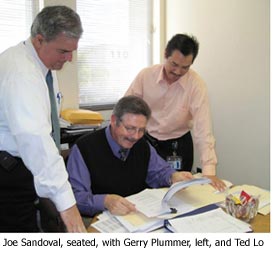 Somewhere out there in the vast universe of Los Angeles County office supplies, a Mini-Jeweleria brown resin fountain pen ($40.50) is feeling the heat right about now.
Somewhere out there in the vast universe of Los Angeles County office supplies, a Mini-Jeweleria brown resin fountain pen ($40.50) is feeling the heat right about now.
So is the Victor 12-Digit Heavy-Duty Two-Color Printing Calculator ($202.46), the Deflect-O® Execumat Heavy-Duty Vinyl Chairmat For High-Pile Carpets ($131.54) and a certain aluminum beveled edge ruler ($4.75). All have been purchased by various departments in favor of far cheaper versions of similar products available through the county’s massive office supplies contract.
No more. As county belt-tightening shifts into high gear—and nearly a year after departments were originally asked to switch to cheaper office supply alternatives—the Chief Executive Office is getting ready to draw a line in the supply closet. And not with some expensive gel ink rollerball pen, either.
Led by Joe Sandoval, the county’s general manager of Purchasing and Contract Services, a team of Internal Services Department employees has been going line-by-line through 18,000 items currently offered as purchase options under the county’s Office Depot contract. The goal is to establish a narrower range of reasonably-priced items in a “formulary” that employees will be required to use when ordering supplies. (See graphic below).
Sandoval says he is not fixated on price as the only consideration. “A 12-cent pen is better than a 5-cent pen,” he acknowledges. But he says that having too many choices of writing implements can lead to some bad decisions.
As for who’s buying $18.63 scissors when there are $1.37 scissors to be had, Sandoval prefers not to name any supply scofflaws. “I don’t want to hang any departments out,” he says.
The interest in reining in the county’s $6 million-a-year office supply habit comes against a backdrop of a countywide push for greater efficiency in a tough economy. A pilot program was launched last year, for example, to use remanufactured toner cartridges, saving $23,847 and prompting a countywide switch to such cartridges for black and white desktop printers and copiers.
There’s also an insider’s website tracking efforts to save money and streamline operations across a wide range of departments. The site features an employee suggestion box, which has attracted 238 entries since October.
As for office supplies, the buy-cheaper memo from county CEO William T. Fujioka last March made the case that simply purchasing less expensive pens could yield a savings of $162,000 a year. A purchasing bulletin issued shortly after provided guidance on the right price point on dozens of items—from butterfly clamps and erasers to rubber bands and steno pads.
But a Jan. 25, 2010, memo from Fujioka announcing the formulary plan pointedly noted the “need for greater departmental attention to purchasing low cost office products.”
Sandoval estimates that the county has saved about $500,000 on supplies in the past 12 months. But he thinks it can do so much better.
“We’re looking at a 30% savings when we complete the 18,000 line items,” he says. “That’s a significant savings.” (A cool $1.8 million a year, in case you don’t have your county-approved calculator handy.)
“It’s the best bang for the taxpayer’s buck—that’s the philosophy,” says Sandoval, 52, a 19-year ISD employee and former member of the Air Force’s security police. “That’s what I’m here for.”
He will allow that out there in “Departmentland,” people can be so focused on their “core businesses” that adopting thrifty purchasing habits is not necessarily their highest priority.
And that’s where the new online formulary comes in.
The work on the project—by a team including Gerry Plummer, division manager of purchasing, and Ted Lo, purchasing and contract analyst—should be finished within the next month or so.
When the 9,000 or fewer approved supplies are listed, catalog-style, in the county’s “procurement module,” anyone who goes in to order will see a pull-down menu of just the right choices—not the extravagant ones.
“They won’t be able to see that $32 pen,” Sandoval says.
A milestone for Expo—and the Westside
February 4, 2010
The Expo Line is ready to roll west.
Directors of the Exposition Metro Line Construction Authority on Thursday evening approved the final environmental impact report for Phase 2 of the light rail project after years of study and months of community input and debate.
The vote clears the way for selection of a contractor to design and build the $1.5 billion project, which would complete the Culver City- to-Santa Monica segment of the 15.2-mile line.
Construction on Phase 1, which parallels the heavily-congested Santa Monica Freeway and runs from downtown to Culver City, is now underway and aiming for completion in 2011. Some work on Phase 2 could begin as early as this year, with the project scheduled to wrap up in 2015. By 2030, the entire line is projected to carry 64,000 riders a day.
Proponents of the line say it will be a boon for anyone who drives to, or from, the Westside, especially those who must battle traffic on the 10 Freeway. For tourists, students and the region as a whole, the completed light rail line will provide access to an array of cultural and community venues in downtown and beyond, including Exposition Park/USC, the Crenshaw District and the beach.
 The vote attracted considerable attention, with hundreds of people on all sides of the issue attending the meeting in the Hall of Administration. In addition, Expo was a hot topic for social networking, with one blogger—Damien Newton of Streetsblog Los Angeles—delivering play-by-play reports on the meeting via Twitter. Albert Ho, an Expo community outreach consultant, also tweeted throughout the proceedings.
The vote attracted considerable attention, with hundreds of people on all sides of the issue attending the meeting in the Hall of Administration. In addition, Expo was a hot topic for social networking, with one blogger—Damien Newton of Streetsblog Los Angeles—delivering play-by-play reports on the meeting via Twitter. Albert Ho, an Expo community outreach consultant, also tweeted throughout the proceedings.
Opponents, many of them with a group called Neighbors for Smart Rail, said they were not against a rail system per se but wanted it to run underground for reasons of safety and quality of life. That option has been ruled out, in part because of the cost.
Those speaking in favor of the plan—an array of homeowners, business people, educators, college students and political leaders from across the region—offered testimony that focused on the need to solve the area’s traffic overload, bring workers to Westside jobs and deliver on the will of the voters who approved Measure R, which will largely finance the rail line.
After nearly four hours of public testimony, the Expo board members had their say.
“This part of town, this part of the county, has waited a long time for this. The time for action has come,” said Zev Yaroslavsky, Expo board member and 3rd District County Supervisor. (Read his blog on the Expo Line project here.)
The Expo Line—together with another project now in the planning stages, the Westside Subway extension—will represent a transit breakthrough for a jobs-rich area that has had to rely on buses for its mass transportation needs as a region-wide rail system has grown up around it in recent decades.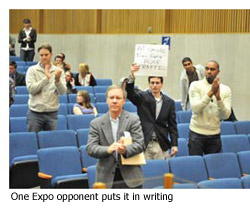
When all is completed, the Expo Line will make it possible to travel from downtown Los Angeles to Culver City in less than 30 minutes, and to ride the entire length of the line in 46 minutes.
“It’s a big step forward for the region,” said Expo board member and Culver City Councilmember Scott Malsin.
“With 200,000 cars coming [into Santa Monica] every day, every one of my streets is gridlocked. I’ve had it up to here with gridlock,” added board member Bill Rosendahl, acting as alternate for his L.A. City Council colleague Jan Perry.
Yaroslavsky, Malsin and Rosendahl joined L.A. City Councilmembers Herb Wesson, Jr. and Bernard C. Parks and Santa Monica City Councilmember Gleam Davis in approving the final environmental impact report. Dan Rosenfeld, acting as alternate for County Supervisor Mark Ridley-Thomas, abstained.
Ridley-Thomas, before leaving the meeting early, had offered a motion that would have delayed a decision on the report until the Metro CEO could finish a review of the agency’s grade crossing policy. That motion was defeated.
The route approved by Expo directors includes seven stations: National/Palms, Expo/Westwood, Expo/Sepulveda, Expo/Bundy, Olympic/26th Street, Colorado/17th Street and Colorado/4th Street.
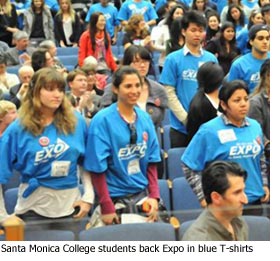 In preparing the final environmental review, the Expo staff received thousands of public comments on the project. Most were supportive but some raised key questions about traffic, grade crossings, parking, noise and vibration, the proximity to schools and the location of the project’s maintenance facility.
In preparing the final environmental review, the Expo staff received thousands of public comments on the project. Most were supportive but some raised key questions about traffic, grade crossings, parking, noise and vibration, the proximity to schools and the location of the project’s maintenance facility.
In addressing those concerns, Expo staff made a number of modifications in the environmental plan presented to the board of directors.
The “locally preferred alternative” plan recommended new elevated grade separations at a number of intersections: Venice Boulevard, Bundy, Centinela, Pico-Gateway, Cloverfield/Olympic and Sawtelle.
More changes came from the Expo board Thursday. On a motion by Yaroslavsky, the directors included an option to build an aerial station at Expo/Sepulveda if funding could be found. The plan also calls for a 170-space parking lot at the Westwood Boulevard station. But the board approved a motion by Yaroslavsky to keep open the possibility of building the station without a parking lot. That could allow for the creation of a landscaped greenway at that location.
In addition, the plan presented to Expo directors recommended a “buffer design option” for the maintenance facility to be built in Santa Monica. The facility would be constructed on what is now a Verizon maintenance yard and a Santa Monica City College parking lot at Exposition Boulevard and Stewart Street. It would include a 100- to 110-foot buffer between the facility and a residential area on the south side of Exposition.
Other changes include allowing parking on the east side of Westwood Boulevard between 7 a.m. and 7 p.m. and doing more to mitigate noise and vibration around such locations as sound and recording studios and schools.
Expo officials describe the line as a “Transit Parkway” that will include pedestrian paths, trees and landscaping, and a bikeway along the alignment, all the way from downtown L.A to Santa Monica. The cities of Santa Monica and Los Angeles have finalized the bikeway design and are awaiting federal environmental approval of the plan.
The plan calls for awarding a preliminary engineering contract by March and a design and construction contract in the fall.
Inmate firefighters get home beyond Malibu
February 3, 2010
In a deal that will be welcome news to Malibu homeowners, the Los Angeles County Fire Department has struck a three-year agreement to house fire teams staffed with state prisoners at a juvenile probation camp in the Angeles National Forest.
The agreement ends the Fire Department’s search for a long-term home for the crews, a quest that sparked protests in mid-January when word leaked that a fire station in the Rambla Pacifico area of Malibu was being eyed as a possible replacement for a fire camp that burned during the Station Fire in August.
Angry neighbors complained that housing the inmates so close to their homes posed a safety risk. The residents also argued that with only one narrow street providing access, traffic from visiting inmate families would be a mess.
Within days of the uproar—some of it based on misinformation—the Fire Department announced it was scrapping the Malibu option.
Under the terms of the new agreement, about 90 state inmates whose fire camp on Mt. Gleason, known as Camp 16, was destroyed last summer will be housed at the Probation Department’s 30-year-old Camp Holton, in the Big Tujunga Canyon, east of Sylmar. The men already had been staying at the facility on a temporary basis since shortly after the fire, which killed two County firefighters.
“This long-term arrangement,” Fire Chief P. Michael Freeman said in a statement, “satisfies the immediate need of the Los Angeles County Fire Department and assures the residents of Los Angeles County that these crews will have an appropriate facility.”
Chief Probation Officer Robert Taylor added: “The overriding issue for both of us was the issue of public safety.”
The fire crews consist of state prison inmates with good behavior records who are serving time for non-violent crimes that include burglary, fraud and DUI offenses. Firefighting inmates have been housed at five locations throughout the county, including a facility for women in Malibu’s Encinal Canyon.
Freeman and Taylor came to terms Tuesday during a meeting at the Probation Department’s Downey offices. How much the Fire Department will pay probation has yet to be negotiated.
In interviews, Freeman and Taylor explained that the arrangement deal to house the inmate crews for a longer stint at the probation camp emerged only recently.
Freeman says his staff conducted preliminary searches at several locations around the county, “but the options were not panning out.” Among those was the Malibu location. Freeman says the department was only scouting potential sites—including the Malibu location—before he was going to approach the state and the community.
The agreement between Freeman and Taylor was reached after it became clear that no other location would work.




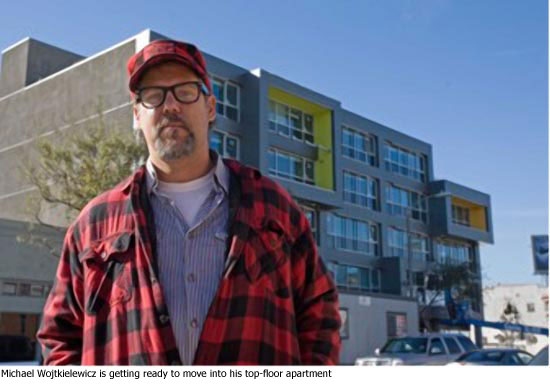

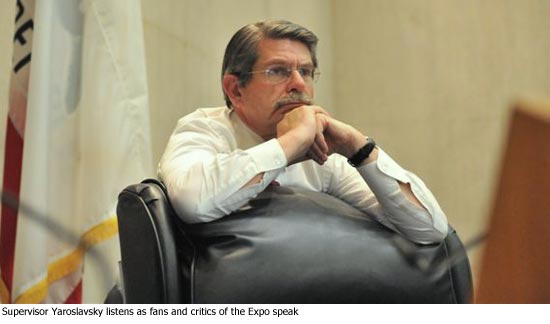
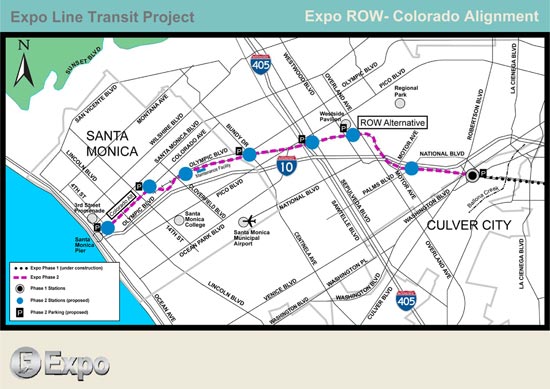
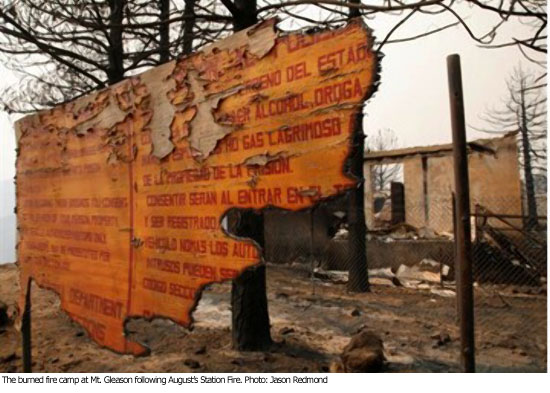





 Check for the latest closure information
Check for the latest closure information








